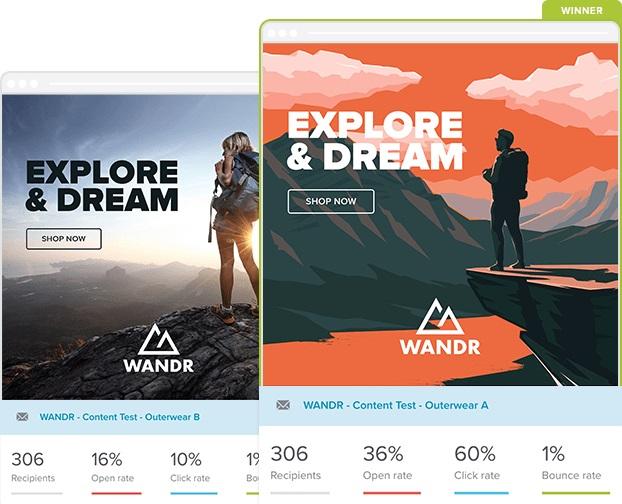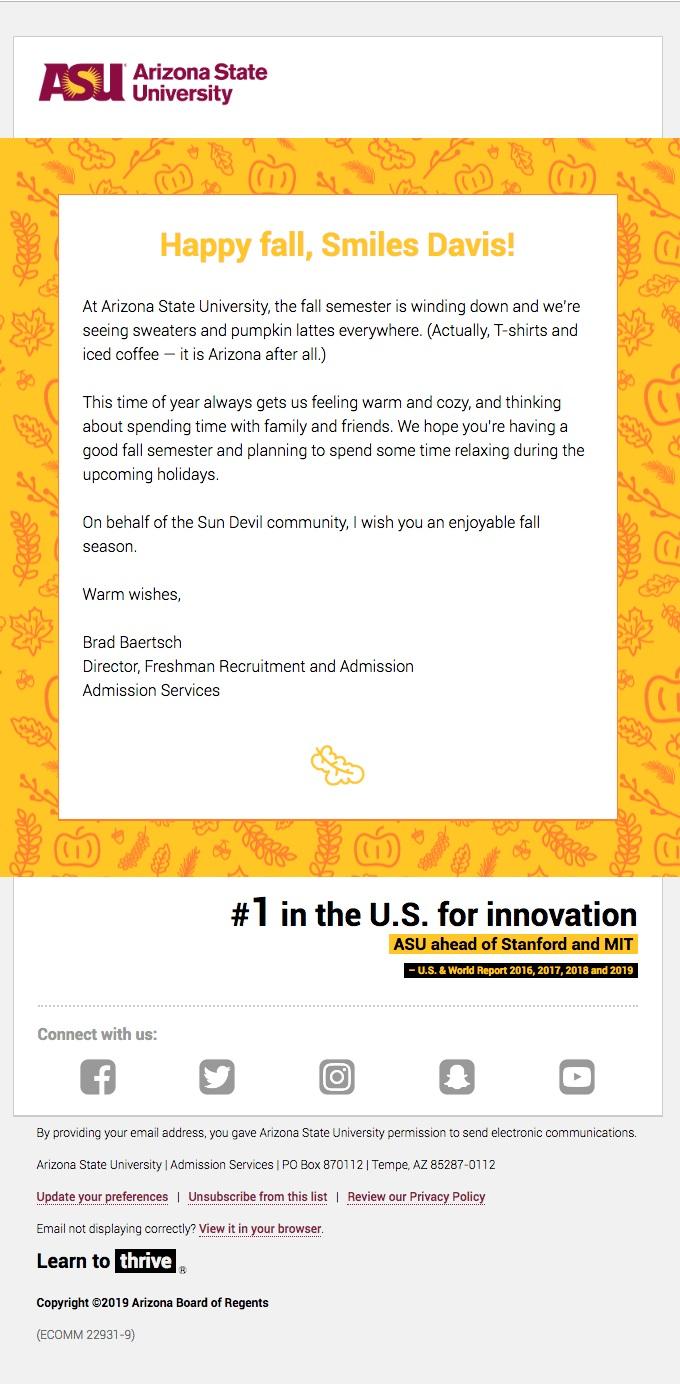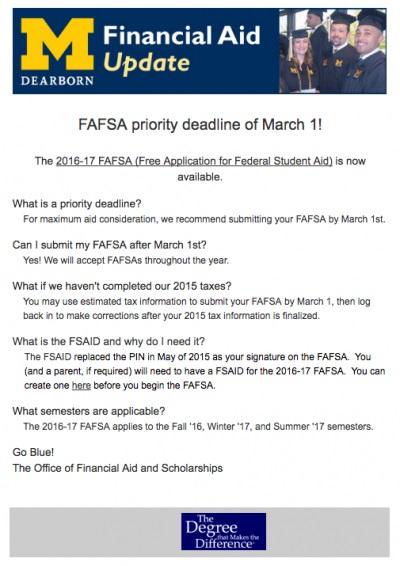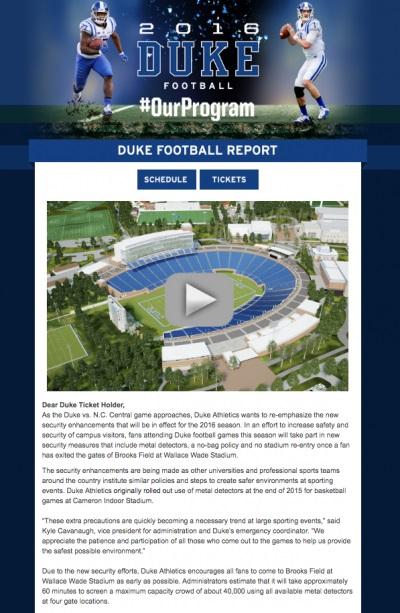Your guide to effective email marketing in higher education
Effective email marketing for colleges and universities is becoming an increasingly hot topic as the state of higher ed evolves, along with its ever-changing student base.
The number of students enrolled in fall 2018 was 19.9 million
In fall 2018, 19.9 million students were enrolled in American institutions. By 2020, these numbers are expected to increase.
With a prediction of increased enrollment rates, and with prospective students submitting an average of eight college applications each, creating a warm and inviting marketing strategy is essential. Having an effective strategy can help not only draw in new enrollments but keep your current students and alumni engaged as well.
However, with any marketing strategy, there are some rather vital do’s and don’ts that should be adhered to in order to see the desired results.
Email marketing works, and here’s why.
Email marketing is not only one of the more affordable marketing methods a university can be taking advantage of, it’s also one of the most effective when it comes to seeing a return on investment (ROI). For every single dollar that the marketing team spends on email marketing, they see an average return of $44.
Email is also near 40x’s more effective than Facebook and Twitter combined when it comes to attracting new customers. Considering the way Gen Z uses social media, this applies to recruiting students, too.
When executed properly, email marketing campaigns can help a university’s enrollment and retention, while actively engaging your current student body and alumni, and driving advancement campaigns.
The problem many universities have is that while they may have an email marketing plan in place, it isn’t always as structured or effective as it could be. In fact, many of the top mistakes higher education institutes often make with their email marketing revolve around inconsistencies and poor-quality testing. And we get it, many university marketers are juggling multiple roles, wearing multiple hats, and working with limited resources, bandwidth, or budgets. (But there’s a way you can still send beautiful and effective emails while still dealing with those limitations.)
Inconsistent branding
Despite most universities having set branding that is used across all marketing materials, one area that they often neglect is their email marketing campaigns. Sure, while some departments get more attention than others, it is vital that a university maintains a cohesive look across all materials, emails, and departments.
Things that often fall through the cracks in university email marketing include:
-
Logo use
-
Color schemes
-
Fonts and font color
-
Consistent photography
-
Consistent iconography
Take this example from Eastern Illinois University. While they have a stunning website, their alumni relations email campaign for their EIU Giving Day Promotion lacks several things, besides an eye-catching design.
First, we don’t see the school’s logo anywhere in the email. It’s a massive thing to leave out—how will your reader know who this email is coming from? And if that’s not clear, they’re likely to not read it. (Would you read an email from a mystery sender?) Another thing that we notice right off the bat is a lack of consistency with the school’s branding colors. The school colors in the email are blue and white. However, the website material shows that their color scheme includes black and grey quite heavily.
Source: Gmail
Sure, this email get’s right to the point—but nothing is telling the reader that this is a legitimate piece of correspondence from this university, besides the sender name.
Takeaway: Brand consistency is vital.
No personalization included
With today’s current marketing tools, personalization and email segmentation have been made very simple for brands. That being said, if you aren’t using proper email marketing tools to get the most out of your campaigns, then not only are you making more work for yourself, you lack the tools to personalize your messages to students, staff, donors, and community.
Emails with personalized subject lines are 26% more likely to be opened, while personalized email messages help to improve click-through rates by an average of 14% and conversions by 10%. For Gen Z alone, one of the best ways to get their attention is to make it clear as day that your email is relevant to them.
Takeaway: Make the email about them in every way you can.
Poor testing
Finally, another significant mistake many universities make when it comes to their email marketing strategy is not testing their campaigns before they send them out.
Utilizing testing methods such as A/B testing can help marketing teams determine how well a given email or campaign will do before sending it out to the masses. Again, having the proper marketing tools can make this simple, considering A/B testing is most effective once you start looking at the number of users who open and click-through your emails.
Takeaway: Testing helps you gauge reader preference, and measure your content performance.
Source: Emma
4 Tips for creating effective email marketing campaigns in higher ed
Optimizing emails for engagement is the ultimate goal for any email marketing strategy, and it should be a top priority for colleges and universities who have to reach and engage a wide variety of readers.
All email campaigns should include:
-
Scannable content for quick, easy reading
-
Incorporate a variety of different mediums, such as event invites, videos, and blog posts
-
A compelling call to action
-
A responsive design so it can be viewed on mobile devices, as well as desktops and tablets
While creating or overhauling an email marketing campaign can seem intimidating at first, these 4 tips will help get the university off on the right foot.
1. Personalize the subject line.
Personalized emails are everything in email marketing, especially when a massive (or more difficult) audience is involved.
A university campus may range in size, but no matter how big or small, a student or faculty member wants to feel apart of the community. The best way to do this is to personalize your email subject line.
Take the following example from Arizona State University. In bright, bold lettering, at the very top of the email is the student’s name.
Source: Really Good Emails
Right away, the reader knows that the campus is addressing them and wishing them a happy fall. Taking the time to recognize the individuals that make up your community not only makes them feel relevant amongst a sea of people, but it will also entice them to open the email to see what it may contain.
Takeaway: Craft your emails as if you were sending each one individually, rather than to a mass list.
2. List segmentation is your best friend.
List segmentation is vital, especially if a university has more than one department that oversees their email campaigns. For instance, not only are there likely to be many different university business departments that students deal with daily, but there are also likely to be many different educational departments (not to mention colleges within departments that may also want to send their own emails).
Source: Emma
Source: Emma
List segmentation ensures that emails get to the audience that will find them useful and relevant. Sending an email from the English Department to a Graphic Design student is not only irrelevant but a waste of time and resources. (Plus, may not be a great look.)
Takeaway: Know your department’s targeted audience and cater to their needs.
3. Always include captivating copy.
Captivating content is how you’ll keep readers interested in what you have to say. Not only does it have to be interesting, but it must also be relevant to the reader.
Source: Really Good Emails
This is a great example of excellent, relevant copy for a college student and their family. The newsletter covers a variety of must-know topics that any student, especially a freshman, may need to know to be prepared for life on campus.
Readers are instantly drawn in thanks to the title, “The money issue—everything you need to know.” University students are known to struggle in the financial department, so having a newsletter to address must-know topics dealing with money is relevant to all students.
Takeaway: Captivate the reader but keep the information relevant.
4. Don’t neglect testing.
The next step, which is missed, is essential. How else is a department supposed to know if their campaigns are paying off or working toward their goals?
Take the Duke Athletics email from earlier—they may have tested a variety of titles, color schemes, and layouts before they decided on the simplistic design and catchy header image.
Testing email campaigns allows departments to see how many recipients not only open the email but also how many click through to get tickets or view the schedule. It is especially important for a department that reaches out to such a large group of readers.
When it comes to smaller departments, such as a university’s English department, they may want to test creative subject lines to entice their readers into opening their email.
Again, this loops back to proper email list segmentation and personalization, even having compelling copy in the body of the email. Each piece of the campaign needs to be thoroughly tested out to see which will garner the best results.
Takeaway: Test each and every piece of your campaign by sending to small sample groups. This will guide you as to what works and what doesn’t with your readers.
Wrap up
When working on effective email marketing in higher ed, there are several things you should keep in mind.
-
Personalization is key
-
Subject lines can make or break an email
-
Copy matters
-
Testing is vital
Having the right marketing tools can not only simplify your email marketing, but give you the option to create campus-wide campaigns, while also allowing individual departments to run more specific campaigns for those working or studying in their department.
Emma helps institutions drive not only student recruitment but also develop stronger alumni and donor relationships—all while increasing student and faculty engagement. See how we can make email work (even better) for you.
MOST RECENT ARTICLES
Want to engage your audience and grow your brand? Try Emma's robust easy-to-use product today.



















